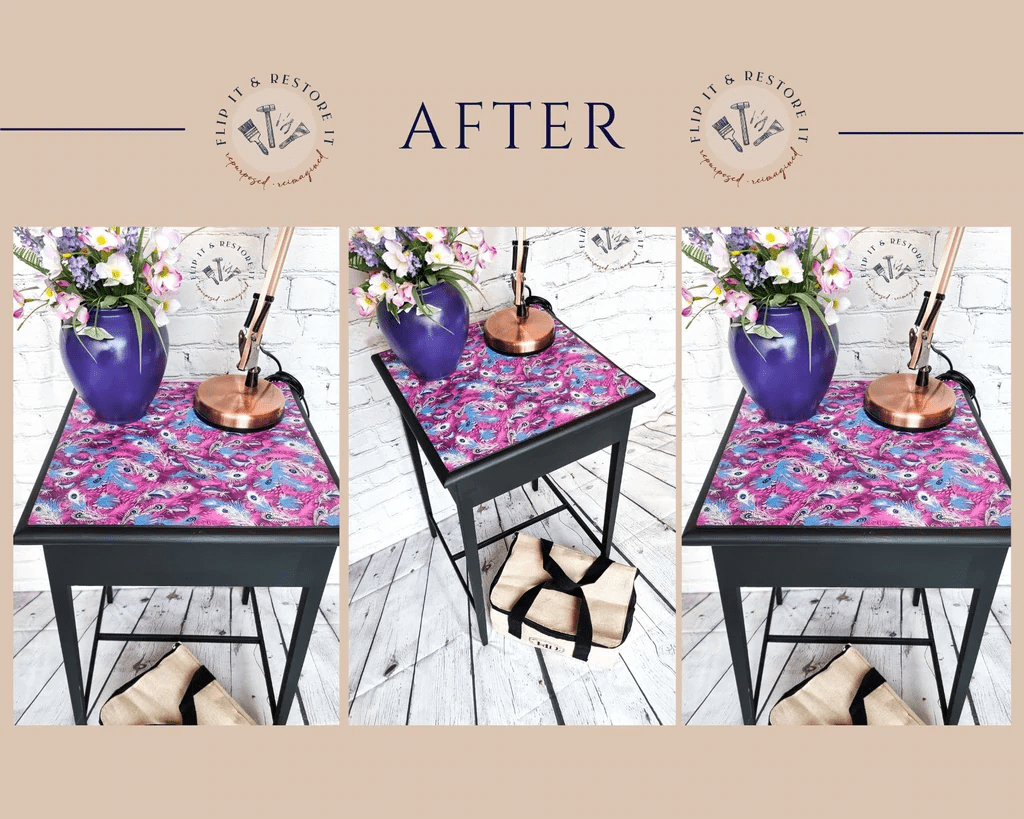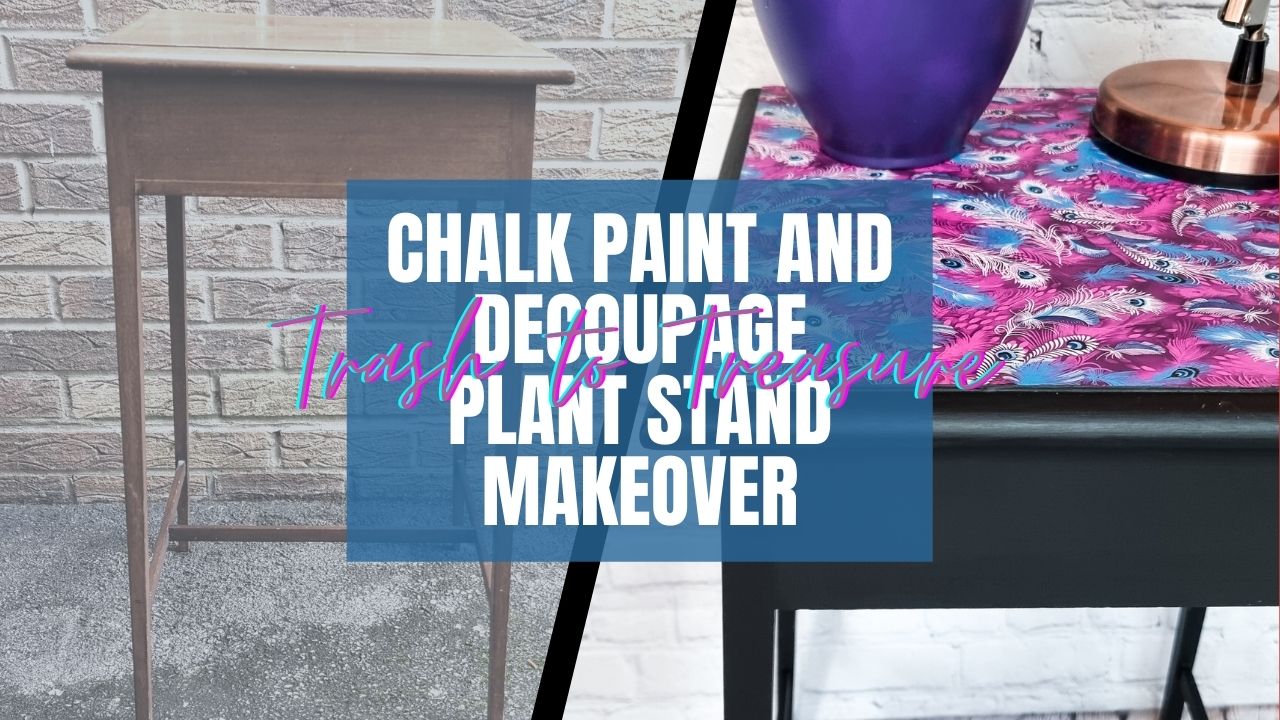Transforming A Plant Stand From Drab to Fab!
* This post contains affiliate links to products. We may receive a commission for purchases made through these links.*
I’ve watched “furniture flippers” for years on YouTube and marvelled at their creative genius. It’s always been on my bucket list to try. Stu, my partner, is fantastic with his hands and is a DIY whizz, and I am in a place in my life where I need a creative outlet. Corporate 9-5 just isn’t cutting it anymore. So, when we decided we wanted a side hustle in 2022, this seemed like a fun and challenging choice. One that we could both get involved with and build together.
We picked up this plant stand/end table for free for our first-ever project on the Nextdoor app. It was just a pretty plain, brown wooden table with not much “pizazz”. We were sensible enough to know that our first upcycle should be pretty small, manageable, and not too overwhelming.
Supplies used for this project:
- Cleaner: Grime Cutter. You could use Sugar Soap as an alternative.
- Sanding: Abrasive Sponge Pads
- Ronseal Wood Filler
- Dixie Belle Chalk
Mineral Paint in Caviar - Dixie Belle Paint Brush Mini Flat
- Décopatch Purple Peacock Print Paper
- Mod Podge
- Dixie Belle Premium Chip Brush
- Dixie Belle Clear Top Coat Flat
- Zibra Palm Pro-Trim Paint

The Process Step-By-Step:
Step 1: Cleaning
The first step of any project is to give your piece a good clean. Now, you may ask why, if you will be sanding it anyway? The reason is that you don’t want to gunk up your sandpaper with grime, and you don’t want to rub that grime into your furniture. It’s also a perfect opportunity to go over your piece and assess what you need to repair. To clean, we used Grime Cutter and a damp cloth. Once you have scrubbed thoroughly, be sure to rinse off your piece with clean water. If you leave any cleaning solution on the surface, this may affect the paint and potentially ruin the outcome of your project.
Step 2: Scuff Sanding
We knew we were going to paint this piece, and the existing finish wasn’t failing, so all we needed was a simple scuff sand. A scuff sand roughs up your surface, making it easier for your paint to adhere and not chip off in the long run. We used a Medium 100 Grit Abrasive Sponge Pad and wiped the surface with a damp cloth to remove any sanding dust.
Step 3: Repairs
There weren’t many repairs needed, except for a few holes on top that needed filling with wood filler. We used Ronseal Wood Filler in the shade Natural. As we were going to be decoupaging the top, we weren’t concerned with colour matching the wood filler; we just needed a smooth base for the decoupage paper. Once the wood filler was dry, we sanded it smooth and wiped the surface with a damp cloth.
Step 4: Painting
The legs and base got two coats of Dixie Belle Chalk Mineral Paint in Caviar. As this is chalk paint, and the consistency is quite thick, we used a mister bottle to dampen our sponge when applying the paint. We can recommend this one from Amazon. The continuous mister bottles have a much more delicate mist of water, which doesn’t soak your piece immediately. The brush we used was the Dixie Belle Paint Brush Mini Flat which works beautifully with the Dixie Belle paint. You need to apply thin layers in even-pressured backwards and forwards strokes to get a good, even finish. With hand painting, invariably, you will have brush strokes (even with self-levelling paint) so if you want to avoid brush strokes – try spraying or using a roller. We allowed half an hour of dry time between coats.
Step 5: Decoupaging
We won’t go too much into detail about the step-by-step decoupaging process as we will write a separate post about that. The decoupage paper was one we picked up from Hobbycraft, and it is the Décopatch Purple Peacock Print Paper. We love the bright and vibrant colours in this design, and we think it contrasts nicely with the black chalk paint. We used Mod Podge to adhere the decoupage paper to the tabletop, which we laid down with a Dixie Belle Premium Chip Brush. Once we laid down the decoupage paper and buddle-free, we sealed it in with another layer of Mod Podge. We left the table overnight to dry.
Step 6: Sealing
The final step was to seal the table to give the paint and decoupage added durability. Our sealer of choice was the Dixie Belle Clear Top Coat Flat which we applied with a Zibra Palm Pro-Trim Paint brush. Again, you only need thin coats spread evenly. Do not keep working in an area and over-work it as the finish won’t come out smooth. Just lay it down, smooth it out and move on to the next section. When applying the clear coat over the chalk painted areas, we added a small amount of the chalk paint to the clear coat to slightly tint it. We did this to reduce the likelihood of the clear coat having a hazy look once it had dried. Three coats of the clear coat all over, left overnight to dry, and we’re done! All that’s left now is staging, photos, and listing it for sale.

You can check out our Youtube channel where we shared a video of our process of upcycling this plant stand from start to finish:
The Numbers:
Plant Stand – £0
Materials – £15
Time – 5 hours
Sold For – We will update this once we have sold the piece!
Do you remember what your fist ever furniture flip was? Was it a success or a fail? Let us know in the comments!
If you enjoyed this post why not share it with your friends and family? As a new blog trying to grow, it would mean so much to us. Don’t forget you can also subscribe to our newsletter for updates when new pieces are added to the site and our latest posts on upcycling, furniture flipping, diys and more!
See you on the next flip!
Brenda & Stu x

